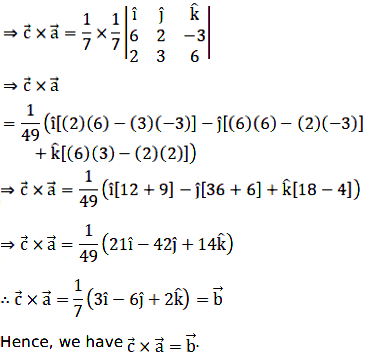To show that \(\vec a,\,\vec b,\,\vec c\) is a right handed orthogonal system of unit vectors, we need to prove the following –

Let us consider each of these one at a time.
(a) Recall the magnitude of the vector \(\text x\hat i+y\hat j+z\hat k\) is

Finally, we will find \(|\vec c|.\)

Hence, we have \(|\vec a|=|\vec b|=|\vec c|=1\)
(b) Now, we will evaluate the vector \(\vec a\times\vec b\)
Recall the cross product of two vectors


Taking the scalar \(\cfrac17\) common, here, we have (a1, a2, a3) = (2, 3, 6) and (b1, b2, b3) = (3, –6, 2)

(c) Now, we will evaluate the vector \(\vec b\times\vec c\)
Taking the scalar \(\cfrac17\) common, here, we have (a1, a2, a3) = (3, –6, 2) and (b1, b2, b3) = (6, 2, –3)

(d) Now, we will evaluate the vector \(\vec c\times\vec a\)
Taking the scalar \(\cfrac17\) common, here, we have (a1, a2, a3) = (6, 2, –3) and (b1, b2, b3) = (2, 3, 6)

Thus, \(\vec a,\,\vec b,\,\vec c\) is also another right handed orthogonal system of unit vectors.